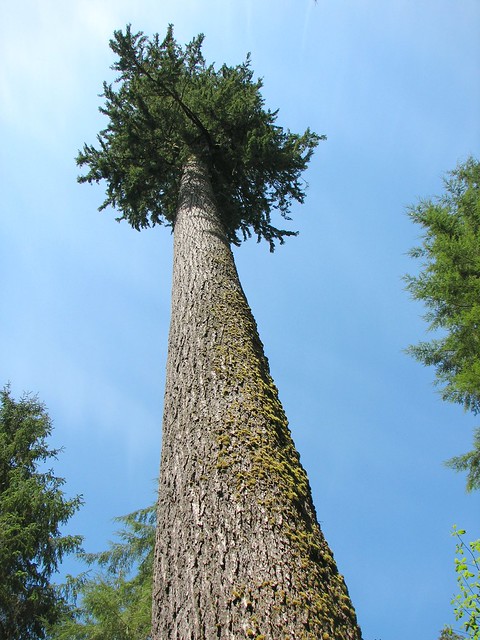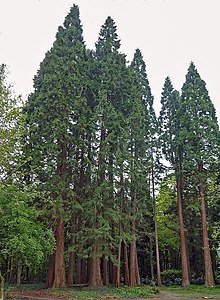 Douglas-fir (Pseudotsuga menziesii)
Douglas-fir (Pseudotsuga menziesii)basic information:
- Member of the pine family
- Native to Western North America, found in both mountains and along the coast
- Can grow up to 380 feet tall or higher in the wild, and have a conical shape.
- Have cones between 3 to 4 inches long
- Not part of the fir family - actually a pine.
- Used for decoration, Christmas trees, and industrial uses, such as for small aircraft.
 |
| Douglas-fir branches |
The Douglas fir was named after the Scottish botanist David Douglas, who introduced many of America's trees to Europe. The tree is similar to many others, so those that discovered it had a hard time placing it. This is why the name Pseudotsuga was used, as it means false hemlock.

Pictured above is the Mineral Tree, a douglas-fir found in Mineral Washington. This tree was estimated to be 393 ft tall by Dr. Richard E. McArdle in 1924. Many other huge Douglas-firs have been found, but this is the best example of what they can before if they are left to flourish. Sadly, the Mineral Tree was cut down for its lumber back in the 20s.

DEODAR CEDAR CEDRUS DEODARA
(member of the pine family)
- Location on campus: along Stevensway
- Average height: 40-70 ft
- Average age: can live for hundreds of years
| Deodar cedar cone and needles |
- Reproductive System:
- The male cones release pollen into the wind usually during spring time
- Deodar cedars are native to western Himalaya region (Afghanistan, Pakistan, and India)
 |
| Deodar Cedar in India |
- Unlike the native redcedar (Western redcedar), needles are bright green and blue-green and in bundles of 20-30 (1-2 inches long)
- Cones are fist-sized and are only produced by female and bisexual trees
- Pyramidal crown when young, but grow wider as it matures
- Branch tips droop

At UW...
Giant Sequoia - aka Sequoiadendron giganteum (giant redwood, sierra redwood, wellingtonia)
Average height - 50-85 meters (160-289 feet) tall, 6-8 meters in diameter
Average age - at least 600 years on the coastal range
Specific Age - not this specific one, but the one by Smith is between 80- 115 years old
Location on campus - by Drumheller in the wooded area, also by Smith hall
Average age - at least 600 years on the coastal range
Specific Age - not this specific one, but the one by Smith is between 80- 115 years old
Location on campus - by Drumheller in the wooded area, also by Smith hall
Reproductive System - regenerate by seed (both male and female cones form during late summer) → mature tree can produce up to 1,500 a year, mature trees cannot sprout from cut stumps
| Bark of Giant Sequoia |
Giant Sequoias naturally grow in a limited area of the Western Sierra Nevada in California, in scattered groves, humid climate characterized by hot summers and snowy winters, do well in fire mineralized soil
UW - There is one giant sequoia behind Smith Hall known as the Meany sequoia, after Edward Meany (legendary history professor and forestry lecturer) who was responsible for some of the first campus tree plantings and established a national seed exchange, but after some policy changes in 1909, many of these trees were cleared (http://www.washington.edu/alumni/partnerships/cfr/201004/didyouknow.html)
Interesting fact - Can withstand fires and cold temperatures up to -31 C (-25 F) as long as the ground around the roots is heavily insulated with snow due to the fibrous, thick,and furrowed bark. Are the worlds largest tree in terms of total volume!
Western Red-Cedar aka Thuja plicata (giant red cedar, pacific red cedar, shinglewood, giant arborvitae)
Average Height - 65-70 m, 3-4 m in diameter
Average age - can reach ages of 800-1000 years
Location on campus - wooded grove, towards Anderson Hall
| Western Redcedar |
Reproductive System - have cones, which produce seedlings in clear cuts or disturbed habitats, but in mature stands vegetative reproduction is more common from layering, rooting of fallen branches, and branch development on fallen trees (http://plants.usda.gov/plantguide/pdf/cs_thpl.pdf)
Habitat - native to northwest uw and southwestern canada, one of most common in PN (20% of regions forests), often associated with Doug Fir and Western Hemlock
naturally common on moist sites (swamps, wet ravines), as well as rocky slopes at 0-1500 meters elevation, usually in mixed coniferous forests, in cultivation they prefer moist, acid, well-drained soils, highly shade tolerant
UW - The Western Redcedar is a very common tree, there is a big one by the HUB that the Daily wrote about a while ago (http://dailyuw.com/news/2008/oct/22/bough-down-campus-trees-a-living-history/)
 |
| Bark of a Western Redcedar |
Interesting Facts - 1. This tree is not technically a cedar, cedrus, but a member of the Cupressaceae family along with cypresses
2. The word plicata comes from a Greek word meaning “folded in plaits” referring to the braided nature of the needles
3. Western redcedars are extremely useful trees, known as “the tree of life”, with medical and practical uses for Pacific Northwest tribes - the wood used to make totem poles, canoes, and other tools, also containing powerful fungicides that prevent decay for years after the tree is dead, and the inner bark used to make mats and ropes, as well as being braided together with goats wool to make important woven robes for tribes like the Haida. Cedar leaf oil is used for bases for perfumes, insecticides, veterinary soap, shoe polishes, and deoderants.
3. Western redcedars are extremely useful trees, known as “the tree of life”, with medical and practical uses for Pacific Northwest tribes - the wood used to make totem poles, canoes, and other tools, also containing powerful fungicides that prevent decay for years after the tree is dead, and the inner bark used to make mats and ropes, as well as being braided together with goats wool to make important woven robes for tribes like the Haida. Cedar leaf oil is used for bases for perfumes, insecticides, veterinary soap, shoe polishes, and deoderants.
English Elm - Ulmus procera (family Ulmaceae)
- Average height - 16-30 meters, sometimes over 40
- Location on campus - Roberts Hall
- Average age - known for longevity, some elms have lived up to 400 years
- Reproductive System
- Elms reproduce “vegetatively”, by sprouting new shoots out of the roots or trunk, known as suckers. Although the plant does produce thin wafer like seeds, these are completely sterile.
- English Elms prefer full sun, moist soils, and are tolerant of atmospheric pollution. Native to continental Europe and middle England
- Brought to UW
- Perhaps because of their tall magestic stature, and hardiness.
- Interesting Fact: Elms used to be associated with death and melancholy, perhaps because they could drop their branches without warning
Coulter Pine (Bigcone Pine) Pinus Coulteri
 |
| Bigcone Pine |
- Location on campus: Left of Anderson Hall (in the corner)
- Average height: 30-80 ft
- Needles are in bundles of 3 and usually 6-12 inches
- Reproductive System: - seed cones mature in 2 years, and begin shedding afterwards
- When it rains, the needles of pine trees release a substance called terpene (volatile hydrocarbons common in conifer as well as citrus trees), which is a natural herbicide and prevents the growth of understory canopy.
- Coulter pine cones are the largest among other pine species and can weigh from 2-10 lbs.




Great content about Doug Fir. I assume you will probably be adding more species to this :)
ReplyDelete